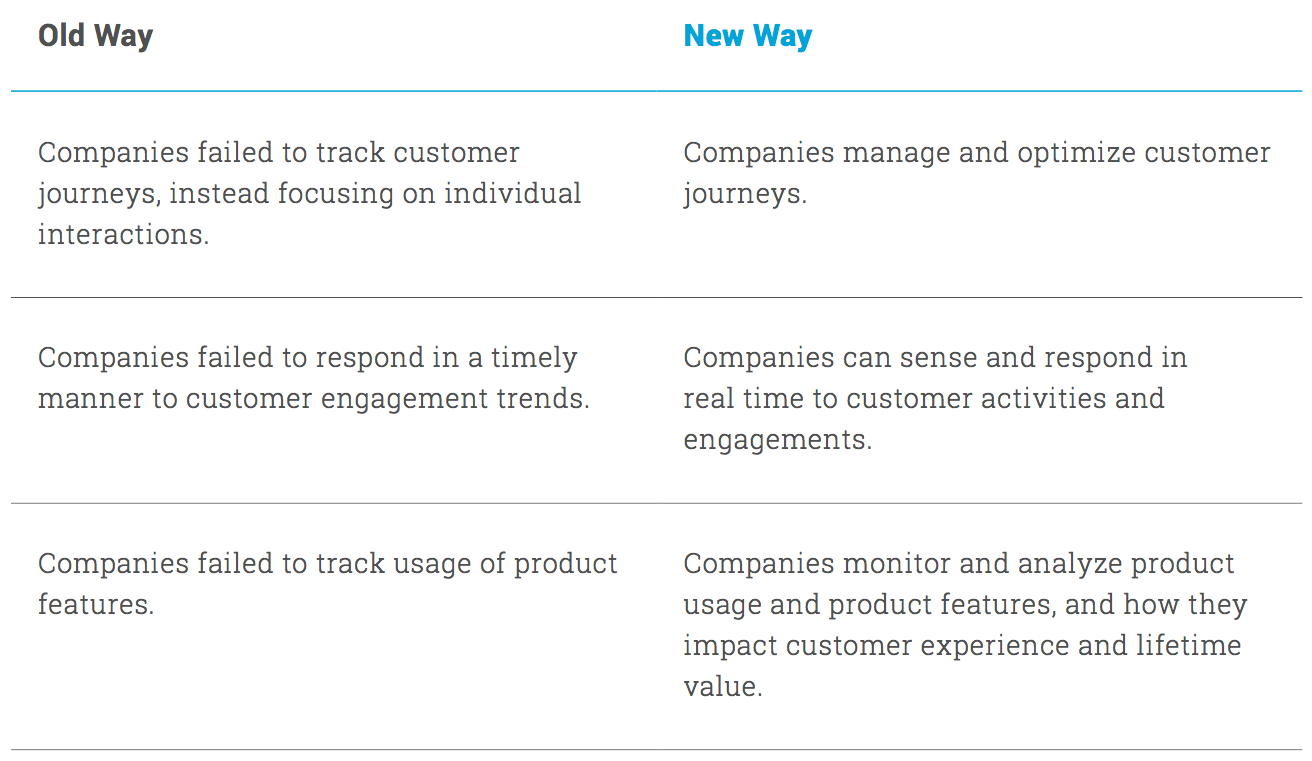Chapter 5: Understanding the Whole Customer Journey

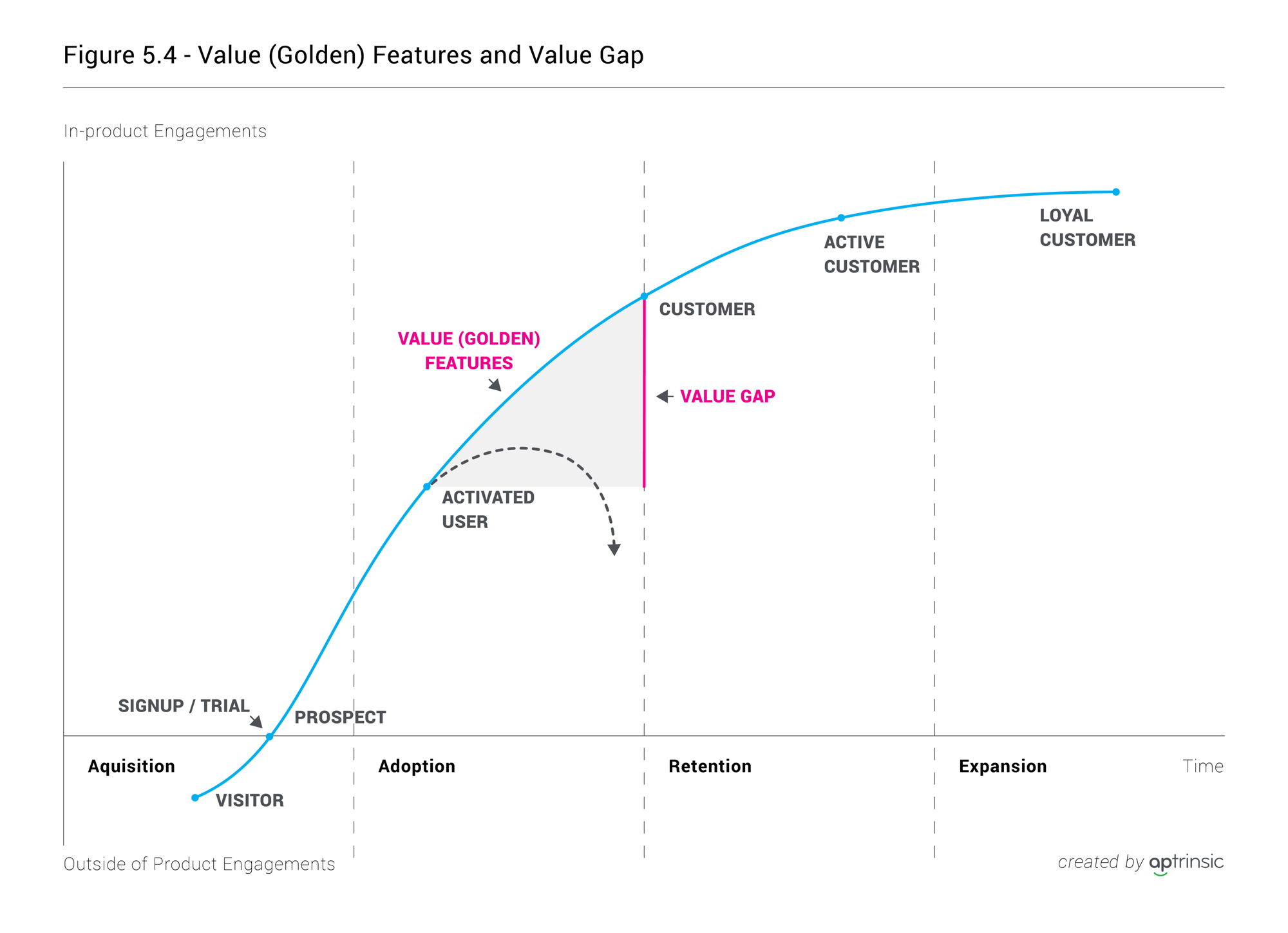
The customer lifecycle encompasses a complete company-customer relationship, from start to finish. In a sense, the customer lifecycle is like your complete life history, and includes birthplace, family history, childhood events, high school years, college, early career, starting a family, birth of children, retirement, and even death. Your life story is filled with journeys and important moments. If you went to college, that journey includes certain interactions and milestones that led you to graduate. Your college journey was filled with decisions and paths you took toward a certain career. In other words, a lifecycle includes many journeys, but there is a clear relationship between the two frameworks.
The customer lifecycle represents all the interactions and journeys a customer has with a company. Journeys, on the other hand, show a sequence of all touchpoints, interactions, and engagements of a customer before that person reaches a journey milestone. While lifecycle is a progression, the journey is the actual path.
The end of each meaningful journey is reaching a milestone. For example, the high school journey ends with graduation day. In SaaS, a free trial signup journey includes all steps that users must take to get inside the product for the first time. As buyers progress through one customer lifecycle stage to another, their journeys can be very unique. One may take a couple of days and four interactions between signing up to becoming fully onboarded. Another’s onboarding journey could span a four-week period and contain twenty interactions.
The customer journey is a series of all touchpoints a customer has with a company, brand, or product to reach a certain milestone.
Journeys can include digital and real-world touchpoints; they can span over many devices and channels.
Each prospective customer goes through unique steps when she evaluates and purchases software. This is why it is extremely challenging for companies to gain a complete picture of important journeys that lead customers to important milestones, such as completing onboarding, using your product for the first time, purchasing the product, reaching daily active user status, or renewing. But the challenge is also in recognizing an optimal pattern.
While individual customer journeys can vary greatly from one customer to another, SaaS companies need to understand the overall pattern. Pattern analysis helps companies understand the most common journey, as well as critical outliers or bottlenecks that prevent prospects from reaching the next stage in the lifecycle.
Improving the customer experience starts with the company understanding its customer lifecycle. The next step is evaluating current journeys, and designing new optimal ones that lead customers to desired outcomes and milestones. Only when an organization understands the complete lifecycle and primary journeys can it effectively design individual touchpoints and interactions. Research suggests companies that focus on customer journeys before designing individual touchpoints are much more successful at enhancing the overall customer experience1. That’s because more touchpoints can make the journey more complex. Overseeing the journey helps teams evaluate the need for each standalone touchpoint, and eliminate any unnecessary ones.
Designing interactions and engagements without outlining the journey can often result in high customer satisfaction with individual touchpoints, but low satisfaction across the journey (2).
One way companies can improve the customer experience is to break down the customer path along the lifecycle into meaningful journeys that act as guideposts. While companies can rarely fully control customer journeys, designing the optimal journey is a great first step. The optimal journey is the shortest and most convenient path for prospective customers to reach the goal.
To summarize, the process of transitioning to a customer-experience company follows these steps:
- Customer lifecycle.
What is the customer lifecycle for our most profitable customers? How can we make this lifecycle as rewarding and frictionless as possible? - Customer journeys.
What are the most important customer journeys? What milestones advance the customer along the lifecycle? - Touchpoints, interactions, and engagements.
What are the most optimal touchpoints and interaction for each customer journey? Can some be eliminated or simplified?
It’s impossible to overstate the importance of understanding customer journeys for enabling a new customer acquisition approach. Enticing prospects to evaluate and try a product via self-service free trials or freemiums opens a unique opportunity for SaaS companies. It enables them to track and optimize in-product journeys that move prospective customers to important milestones, such as realizing initial product value.
Therefore, monitoring customer journeys is a crucial step. Instead of looking at just a part of a transaction or experience, the customer journey documents the full experience of being a customer.
5.1 Tracking Customer Journeys
A customer journey can consist of online and offline interactions. Digital (or online) touchpoints can happen outside of a product, or in-product. Remember, in Figure 3.1, the x-axis divides the customer lifecycle into out-of-product and in-product engagement areas.
We’ve explored the shift of SaaS companies away from lead generation forms that focus on customer journeys and interactions outside of their product to free trials and signups that focus on in-product customer journeys.
Let’s focus on in-product customer journeys, as they are the most effective way for a prospective customer to experience true value from the product as they move along their customer lifecycle.
In-product customer journey is a sequence of all touchpoints that a customer has inside the product.
Providing customers access to the product early in the acquisition stage reduces the reliance of teams on non-product customer engagements. It also increases the importance of product engagements. Table 5.1 shows examples of in-product and out-of-product engagements.
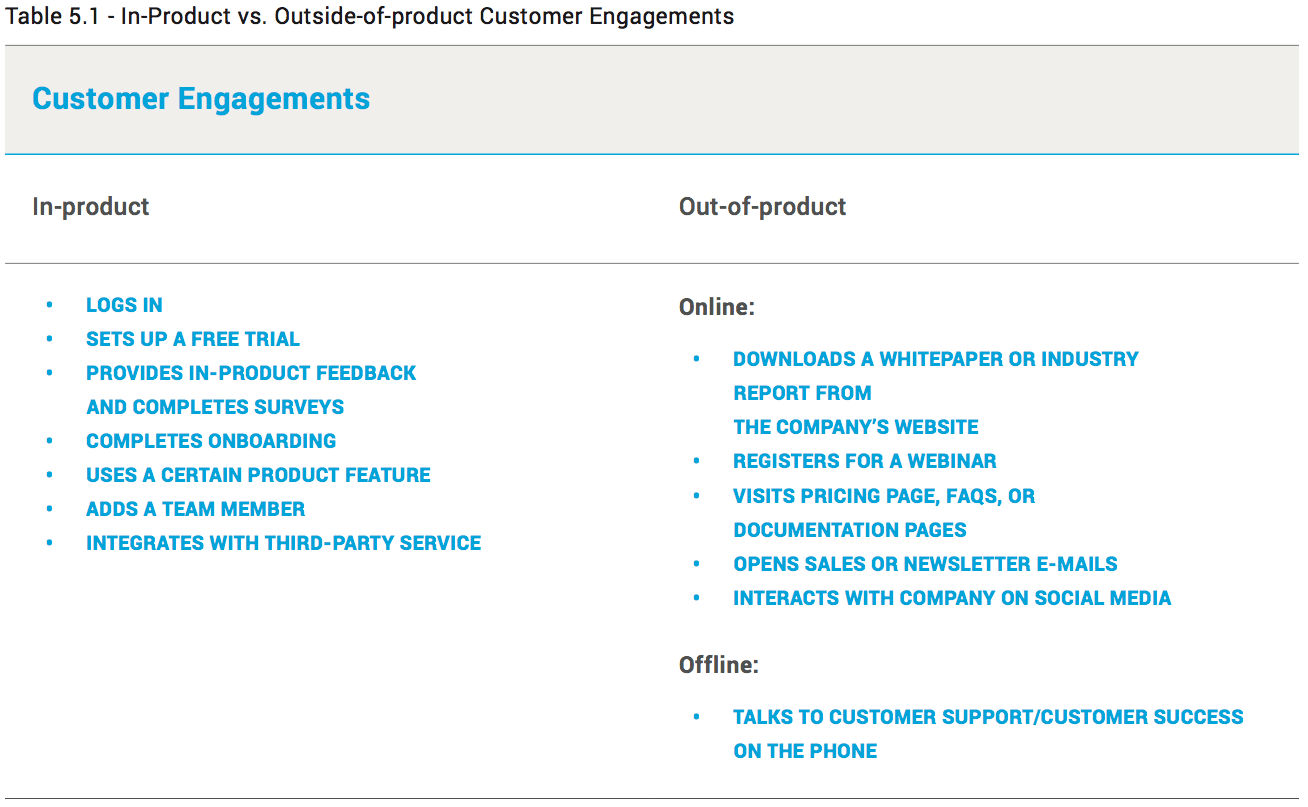
Let’s illustrate how we think about customer journeys at Aptrinsic. For this purpose, we’ll compare the in-product journeys of Prospect A and Prospect B through the acquisition and adoption stages of the customer lifecycle. Both journeys include out-of-product and in-product touchpoints and interactions.
At Aptrinsic, we define initial value as when a prospect installs our JavaScript (JS) code and starts collecting product analytics data. The optimal customer journey to reach this milestone follows this sequence:
- Visit website
- Sign up for free trial
- Complete the product tutorial
- Set up product
- Install JS code into the product
Now, let’s review two hypothetical journeys by two prospects: John and Danielle.
John starts the journey by clicking on a social media post, then visits the website and signs up for a free trial; the website visit is a non-product engagement. The free trial signup identifies John as a prospect, and from that point, we track all product interactions. John completes the onboarding tutorial, but leaves right after.
We send a reminder e-mail to him; John opens it, but doesn’t return to the product. Two days later, we send another reminder to entice John to come back, create a product, and install JS code. This time, John returns to the app and creates a new product that generates a unique code. Since we are not collecting any data for John’s product, we know he didn’t install JS code, so we send a reminder e-mail. The next day, Aptrinsic starts collecting analytics data for John’s product, which means he installed the JS code. The journey to realize initial value is complete. Reaching this milestone allows John to track and analyze his product inside of Aptrinsic. It also allows us to track his product usage and optimize his engagement.
Overview of John’s journey:
1 — Clicked on social media post
2 — Visited website
3 — Completed signup/free trial
4 — Completed onboarding tutorial
5 — Opened nurturing e-mail (not returned to the product)
6 — Opened reminder e-mail (no activity for 2 days)
7 — Set up product
8 — Opened e-mail reminder to install JS
9 — Installed JS code, data collected
Figure 5.1 represents a 9-step process that John took to reach the milestone of collecting product usage analytics. It should be clear that touchpoints 1, 2, 5, 6, and 8 happened outside of the product. Touchpoints 5, 6, and 8 are e-mail reminders triggered by John’s inactivity.
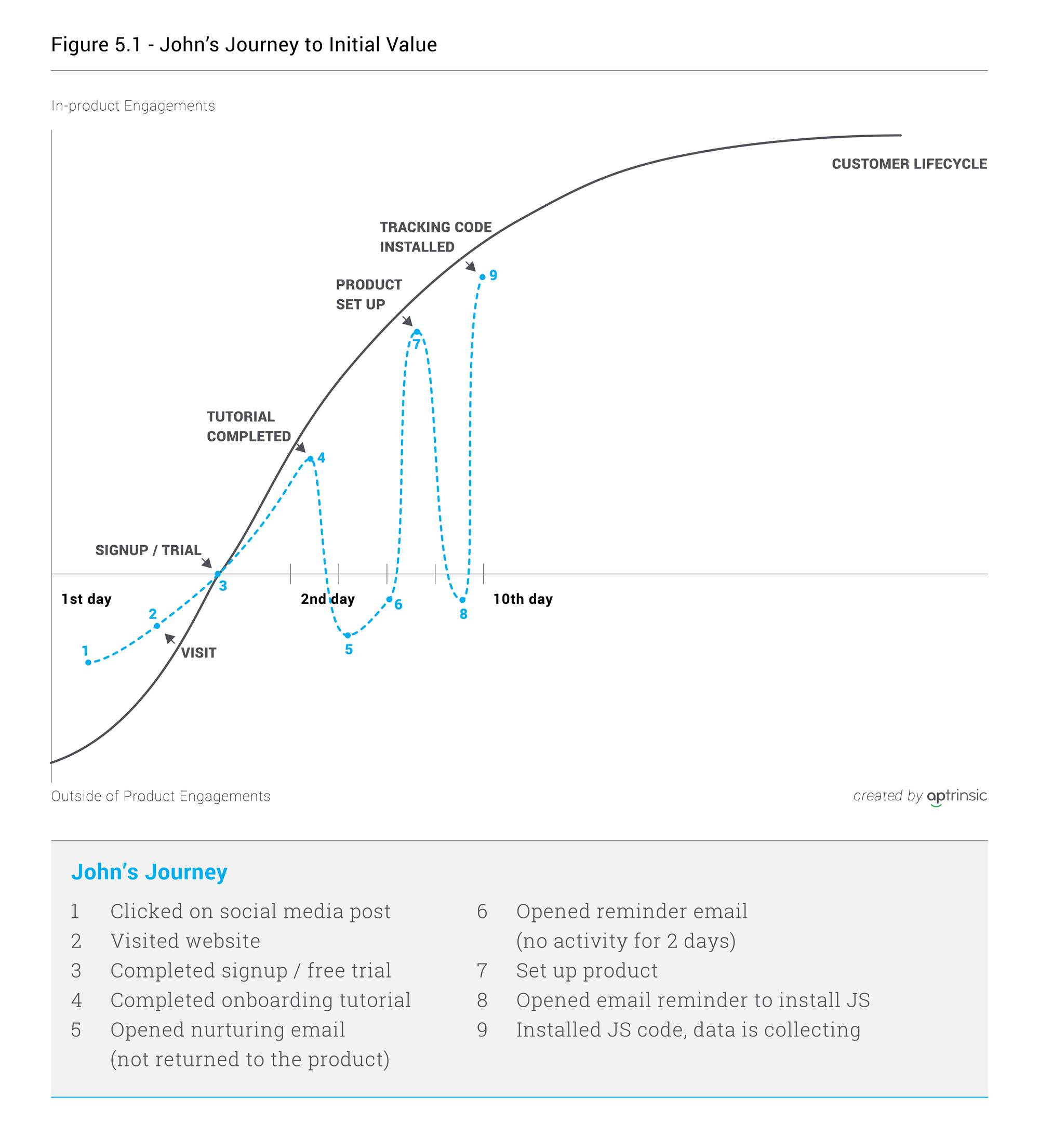
John completed this journey in 10 days:
- 1st day: visit, signup, onboarding tutorial
- 2nd-3rd day: no activity
- 4th day: e-mail reminder
- 5th-6th day: no activity
- 7th day: e-mail reminder, created new product (generated JS code)
- 8th-9th day: no activity
- 10th day: e-mail reminder, tracking code implemented, data collected
In this hypothetical scenario, John received two reminder e-mails to create a new product, and one reminder e-mail to install JS code. All three e-mails were triggered by John’s inactivity, and all three guided him to continue the journey where he left off. Now, let’s compare this journey with the journey taken by Danielle.
Danielle starts with the same touchpoint as John, and signs up for a free trial; but unlike John, Danielle engages with the product right away using essential product features that showcase the initial product value to first-time users. During the initial free trial signup, Danielle completes onboarding and creates a new product that generates a unique JS code. She then logs in to the product the next day and receives an in-product notification to install the JS code and start collecting product analytics data.
Overview of Danielle’s journey:
1 — Visited website
2 — Completed signup/free trial
3 — Completed onboarding tutorial
4 — Set up product
5 — Logged into product and received in-product reminder
6 — Installed JS code, data is collected
Figure 5.2 shows a step-by-step journey for Danielle to reach initial value as we define it at Aptrinsic.
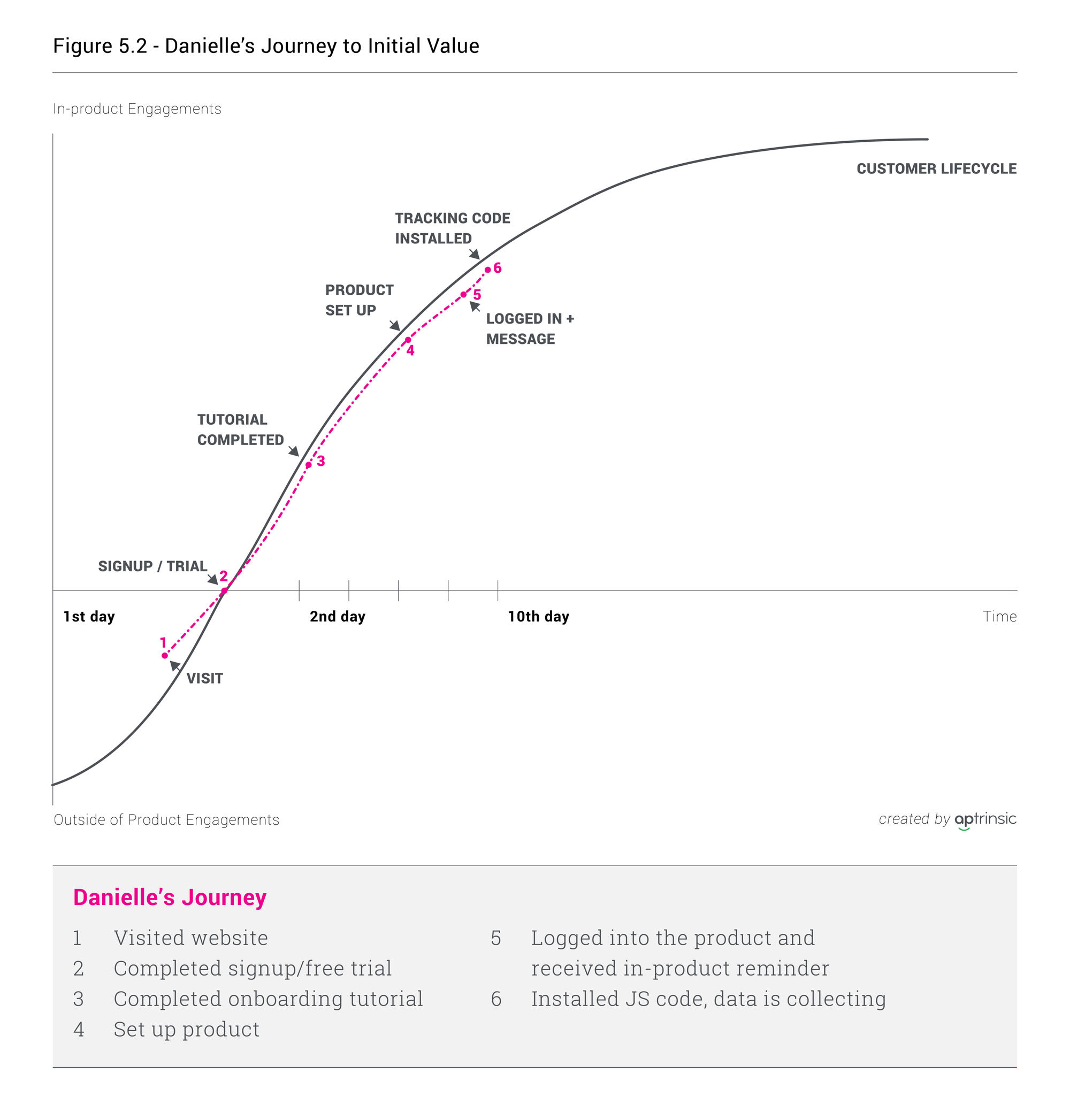
In this scenario, Danielle completed the journey in two days, with fewer touchpoints:
- 1st day: visit, signup, tutorial, created new product
- 2nd day: logged in, saw in-product reminder, installed tracking code
Table 5.2 lists all the steps in the journeys of the two prospects. Danielle completed these steps in a much shorter timeframe, which could indicate a higher buying intent.
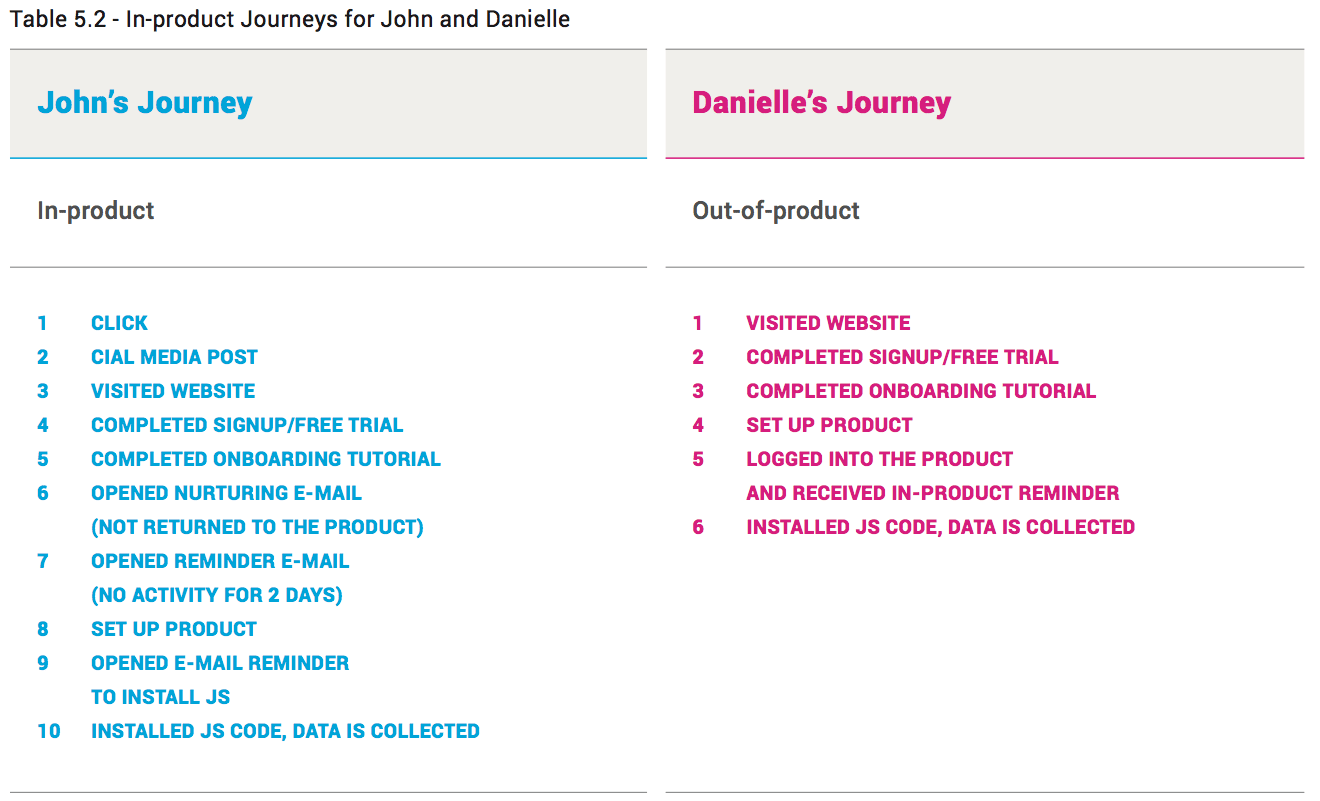
Figure 5.3 shows both journeys in the context of the customer lifecycle. We gave an example of just one journey type, but as prospects progress, the next journey will lead them to set up our product mapper. When that step is completed, the prospect will be guided to design and launch an onboard experience; and the journey to the fourth milestone will be complete when the prospect creates and sends the first e-mail or in-product message.
The velocity with which a prospect moves through the lifecycle to reach the next stage is a very important factor to consider and prioritize. Shorter time to value will likely correlate with higher probability to close and to become a highly satisfied DAU.
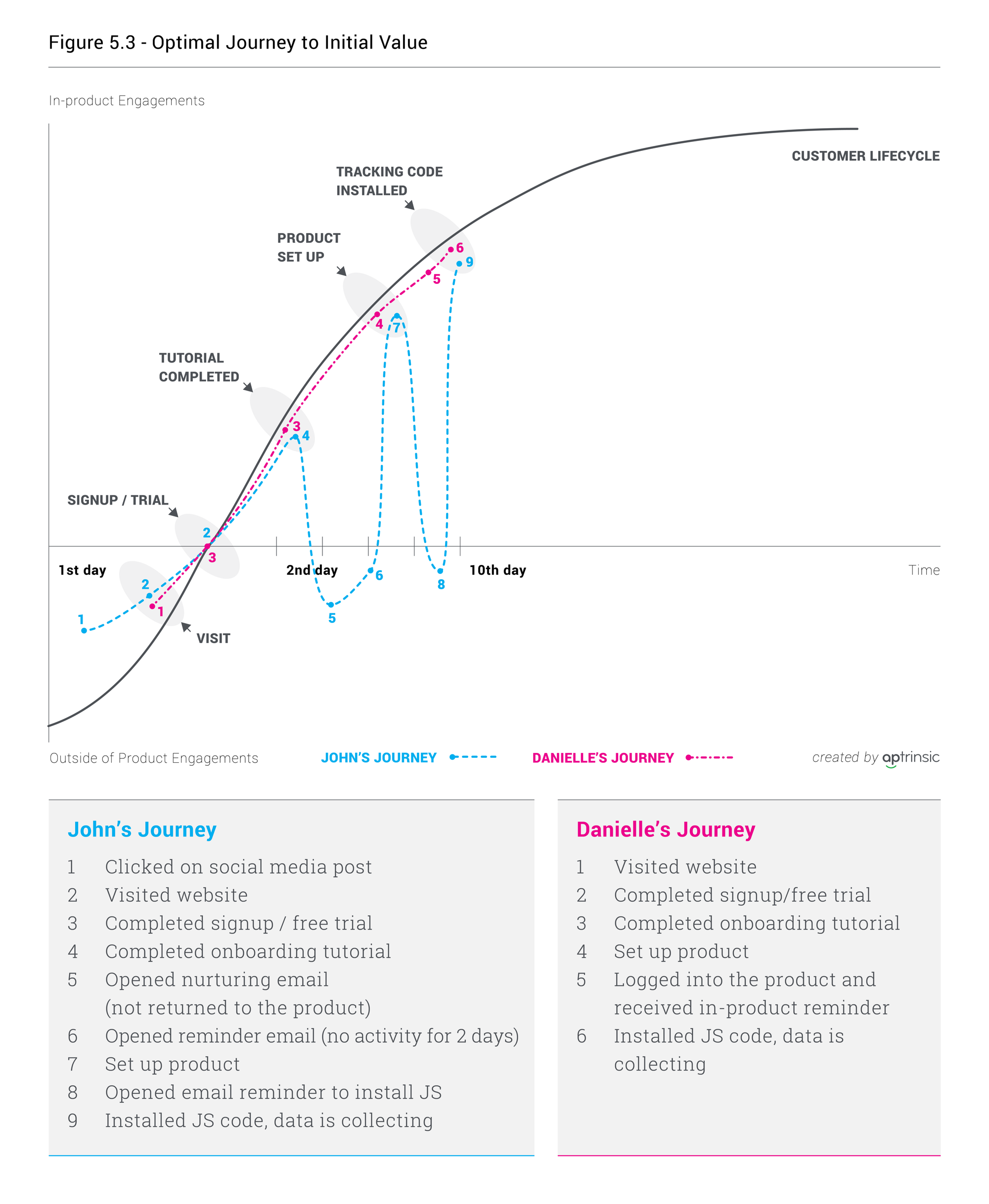
If we plotted many customer journeys into the customer lifecycle, we could identify the optimal path to initial value. Additionally, we could understand better the average time it takes to travel this journey, and steps where prospects get lost or fall off. Customer journey analysis provides companies with tremendous insight into understanding and optimizing journeys that directly impact the overall customer experience.
Every touchpoint and interaction along the journey is an opportunity for the company to influence the prospective customer’s impression and create a deeper relationship between the company and prospective customer. This is what could be referred to as a Moment of Truth.
A Moment of Truth (MOT), in marketing, is the moment when a customer/user interacts with a brand, product, or service in a way that serves to form or change an impression about that brand, product, or service.
Potentially, every touchpoint in the journeys of John and Danielle is a moment of truth.
5.2 Mind the Value Gap!
Not every prospect who signs up for a free trial becomes a customer; and not every customer will renew the subscription. Let’s look again at the journey of John. During the initial signup, he completed the product tutorial, but then left and didn’t return to product for four days, until he received the second e-mail reminder.
But in many cases, users leave the product, never to return after the initial signup. Often prospective customers’ needs are not met because the product doesn’t provide enough value, or because the prospective customer expected something completely different.
“Customers attach value to products in proportion to the perceived ability of those products to help solve their problems.” — Theodore Levitt, The Marketing Imagination
This is what we call a Value Gap. It is a difference between expected and delivered (or perceived) value. John might have never returned to the product after completing the onboarding tutorial. Maybe, in that case, he expected something different from the product, or the tutorial didn’t do a good job enticing him to complete the next steps to realize the value from the product.
A Value Gap is the discrepancy between what a customer expects from the product and the value received or perceived.
The perception of value is as important as the value itself. If, for example, if a prospect doesn’t know how to use your product or has an incorrect perception of its value, the result can be a Value Gap that will influence the prospect’s behavior and buying decision.
A Value Gap can happen for many reasons, but here are some big ones:
- Product fails to provide adequate value
- Customer is the wrong fit for the product
- Customer doesn’t understand a product’s capabilities or how to use it
- Customer experiences something jarring or painful (i.e., confusion, dissatisfaction, competitive incentive, etc.) that changes their perception while using the product
In the first scenario of the product not actually showing enough value, the company needs to go back to the drawing board and radically change the product to increase real and perceived value in the eyes of prospective customers. If a prospect is a wrong fit for the product, the problem may be that your marketing and outbound sales team is focusing on the wrong customer segments.
In the third and fourth scenarios, the company fails to communicate value through product capabilities/experience, and doesn’t educate prospects on how to effectively use the product. To address these issues, teams can create a wide variety of product engagements and customer-centric journeys, to guide customers from first product touch to initial value.
In the example of John and Danielle’s journeys, we defined initial value as a milestone when the prospect installs tracking code and starts collecting product analytics data. This data is the first step to understand how our product works, and to realize initial value. The concept of initial value is closely related to the Desired Outcome3 concept, described in detail by customer success expert Lincoln Murphy.
Initial value is when a customer first experiences product value.
Realizing initial product value is the first step toward understanding how a product is intended to work, and what problem it was designed to solve. SaaS companies must carefully design the journey toward realizing initial value, as it is one of the most important journeys. This is the first time a user interacts with your product, and it’s a real moment of truth. Companies not only need to identify the initial value, but also design optimal customer journeys that deliver it in a timely manner.
We will come back to discussing initial value when we talk about onboarding later in the book. But for now, let’s see how different companies define initial value:
- For Asana, initial value can mean creating a new project, with tasks successfully assigned to a team member.
- For Zoom.us, it can mean signing up, organizing, and holding the first video conference.
- For Expensify, it could be creating the first expense report that is approved for payment.
- For Aptrinsic, initial value is delivered when a customer signs up, installs our tracking JS, and starts receiving product usage data from their customers.
The shorter the time to initial value, the more likely it is that a prospect will stay long enough to become a customer. In the scenarios we used, Danielle realized value in much less time than John.
5.3 What are Value or Golden Features?
Value Gap is often a result of the failure by prospects to complete journeys and interact with the most important product features.
Value features — sometimes known as “golden features” — are a set of product features that a prospect or customer must use to realize value and advance to the next stage of the customer lifecycle. During customer acquisition and adoption, value features guide prospects through a core use case, which is a common customer journey that users experience on a regular basis. Think back to the Aptrinsic example, and the way we guide prospects to install JS code to start collecting data. Prospects who experience value features are more likely to convert to customers.
When an activated user’s product engagement declines, it causes a Value Gap. To close the gap, the company needs to immediately re-engage the customer.
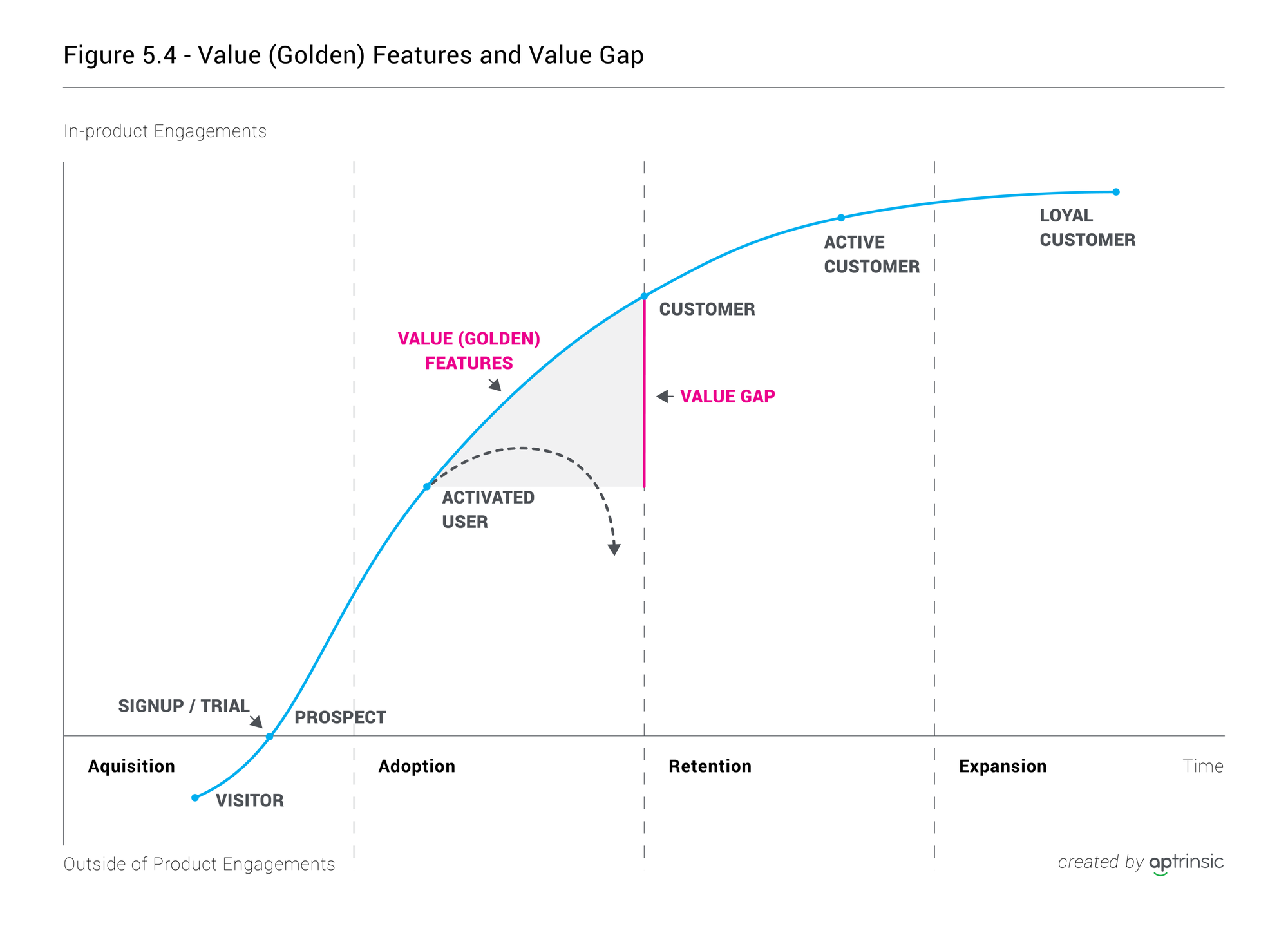
Figure 5.4 illustrates a Value Gap that an activated user can experience as a result of not engaging with product’s most valued features. Let’s point out a couple of important things regarding Value Gap and value features.
First, SaaS companies need to identify when a prospective customer’s engagement changes — or potentially changes — in adverse ways, why it happened, and what features weren’t used.
Companies can automate timely responses based on these behavioral insights in order to re-engage customers in meaningful ways, such as educating and reminding them about value features. We call this an Engagement Loop, which is a practice of using insightful in-product usage data, along with engagement tactics, to influence prospects and customers to re-engage with the product and experience more value.
In essence, customer lifecycle optimization means creating an ongoing process of sensing and responding to customer behaviors and feedback. The rate of growth in SaaS correlates with how effectively the company is creating loyal customers who renew or purchase higher subscription levels. We call this a Loyalty Loop, a continuous process of delivering substantial value and customer experience to keep customers using the product, adopting new features, increasing usage, and renewing.
Companies that master the process of creating loyal customers increase CLV and competitive advantage. Out of all tangible and intangible assets that your company has, customer loyalty is only one of three items that can’t be easily copied by your competitors, according to Marketing: A Love Story — How to Matter to Your Customers by Bernadette Jiwa. Reputation and trust are the other two.
5.4 Key Takeaways
- An in-product customer journey is a set of all prospect/customer touchpoints inside the product.
- Giving prospective customers access to the product early in the acquisition stage reduces a marketing team’s reliance on engagements outside the product and increases the importance and impact of product engagements.
- While they’re in the product, prospects and customers are more likely to experience a MoT, when they form or change an impression about the brand, product, or service.
- A Value Gap occurs when there’s a discrepancy between what the customer expects from the product and the value he or she actually receives or perceives. The company then must re-engage the customer right away to close the gap.
- An Engagement Loop uses product usage data to influence prospects and customers to re-engage.
- A Loyalty Loop delivers substantial value and experience to keep customers using the product and adopting new features, leading eventually to renewal.
- The initial value unit is an engagement, or set of engagements, that advances the customer through a core use case. Valued (golden) features are ones a prospect or customer must use to realize initial value.
